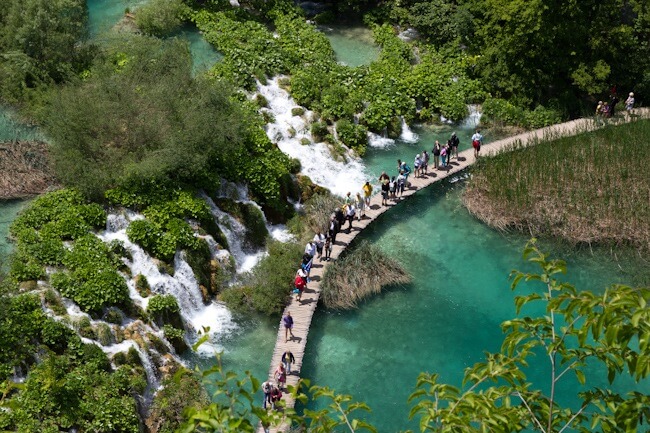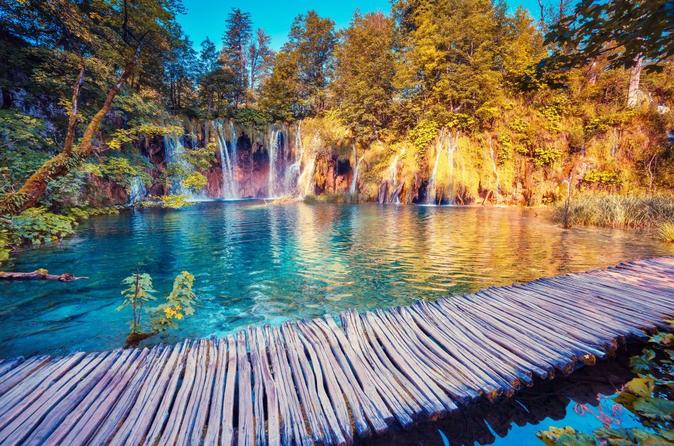
Within the boundaries of this heavily forested national park, 16 crystalline lakes tumble into each other via a series of waterfalls and cascades. The mineral-rich waters carve through the rock, depositing tufa in continually changing formations. Clouds of butterflies drift above the 18km of wooden footbridges and pathways that snake around the edges and across the rumbling water.<br />
It takes upwards of six hours to explore the lakes on foot, or you can slice two hours off by taking advantage of the park's free boats and buses (departing every 30 minutes from April to October). From Entrance 2, catch the bus to the top of the upper lakes and wander back down to the shore of Kozjak, the park's largest lake (about 4km in length). A boat will whisk you from here to the lower lakes, where the circuit culminates in the aptly named Veliki Slap, the tallest waterfall in Croatia (78m). The path then climbs steeply (offering great views and photo opportunities) to a bus stop, where you can grab a lift back to Entrance 2.

If you've got limited time, the upper lake section can be completed in two hours. The lower section takes about three, although we recommend that you start with the bus ride and end with the boat to save yourself a climb.
Note that swimming is not permitted in any of the lakes.
The Plitvice Lakes National Park, Croatia’s most popular tourist attraction, was granted UNESCO World Heritage status in 1979. Located roughly halfway between capital city Zagreb and Zadar on the coast, the lakes are a definite must-see in Croatia. (As confirmed by the many emails we’ve received!)
The beauty of the National Park lies in its sixteen lakes, inter-connected by a series of waterfalls, and set in deep woodland populated by deer, bears, wolves, boars and rare bird species. The National Park covers a total area of 300 square kilometres, whilst the lakes join together over a distance of eight kilometres.

There’s also quite an altitude difference – the highest point is at 1,280m, the lowest at 380m – although the total height difference between the lakes themselves is only 135m. (Veliki Slap, the largest waterfall, is 70m tall.)
If you’re undecided about whether or not to visit Plitvice Lakes, take a look at any photo album of the Park and that will surely sway you! The official Plitvice Lakes website has a fantastic virtual tour that features some truly stunning scenes.
Or, for another prewiew, check out our Plitvice Lakes Photos!
Getting to the Plitvice Lakes National Park
See our page on Getting to the Plitvice Lakes National Park for details on how to get there by public transport or organised excursion.
If you’re driving to the Park, there is parking at both entrances. It costs 7 Kuna per hour for cars.
Visiting the Plitvice Lakes National Park
The Park is open daily all year round, with longer opening hours during summer (usually 7am to 8pm). There’s an entrance fee which acts as a contribution to the Park’s upkeep and protection: for adults it’s 55 Kuna (£5.50/€7.25/$8.50) January to March and in November and December; 110 Kuna (£11/€14.50/$16.50) during April to June and in September and October; and 180 Kuna (£18/€24/$27) in July and August.

Children aged 7 to 18 have cheaper tickets, whilst children under the age of seven go free. Students also get discounted entry, and groups of 15 or more (whether adults, students or children) can also get discounts.
2-day tickets for the Park can also be purchased, which provide you with some cost savings.
4-hour guided tours in English, German, French, Spanish, Italian or Croatian can also be pre-booked for a minimum of 15 people at an additional cost.
There are two entrances to the Park – excitingly titled Entrance 1 for the lower lakes and Entrance 2 for the higher lakes. Entrance 2 (and therefore some of the park) is normally closed in winter (November to April).
Full details of ticket prices can be found on Operating Hours and Prices page of the Plitvice Lakes National Park website.
Plitvice Lakes National Park
Sightseeing in the Plitvice Lakes National Park
See our special page on Exploring the Plitvice Lakes National Park.
The best time of year to visit the Plitvice Lakes
Plitvice Lakes isn’t just for summer. It’s a stunning place to visit any time of year as the different seasons see the Park take on different hues, whether that’s lush greenery in spring/summer, rich colours in autumn, or magical scenes in the snow and ice in winter. Even if conditions are rainy, the park can still be wonderful to explore as the water takes on a dramatic effect – sometimes bubbling up underneath your feet on the wooden pathways!
Understandably, Plitvice can get very busy during summer and the pathways can be quite crowded. We’d ideally recommend a spring/late summer visit when the weather is still good, the park is open for relatively long hours but there should be fewer people.
Do note that the Entrance 2 (lower lakes) is normally closed in winter – but there’s still plenty to explore from Entrance 1.

Accommodation in the Plitvice Lakes
It is possible to stay right next to the Park at one of its three hotels (which are all clustered quite closely together by Entrance 2) or at its campsite, Camp Korana (which contains bungalows or space for 500 camping units), which is about 7km from entrance 1. Another campsite, Camp Borje, is 15km away from Entrance 2. There is another hotel, the Hotel Grabovac, that is also located 12km north of the Park.
There is also a very wide selection of private accommodation (rooms, apartments in guesthouses and similar) in the region. There are some options very close to the park entrances, but also plenty of choice in a number of the towns and villages (such as Slunj) on the way to the Park. If you don’t have your own car, do make sure you pick an accommodation choice that’s walking distance to the Park! (Or perhaps arrange transfer options with the accommodation owners.)
See our Accommodation in the Plitvice Lakes page for a detailed listing of all of the above options.



